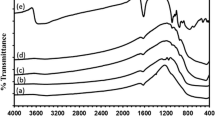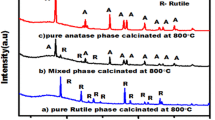Abstract
Nitrogen-doped titanium dioxide (N/TiO2) nanophotocatalysts were successfully synthesized in the presence of environmentally benign nitrogen dopant source, guanidinium chloride, by the sol-gel method. The effect of calcination temperature (300–600 °C) on their physicochemical properties was investigated by means XRD, XPS, FESEM, HRTEM, Raman spectroscopy, UV-vis DRS, PL and BET. Moreover, their photocatalytic activities were evaluated against rhodamine B (RhB) degradation under direct sun light. Results showed that the crystal phase of spheroidal N/TiO2 nanoparticles was changed from anatase (300 °C) to rutile (600 °C) via an intermediate anatase/rutile (A/R) mixed phase (400–500 °C), and the RhB photodegradation performance was increased with the decrease of the calcination temperature. Notably, N/TiO2 prepared at 400 °C demonstrated the best degradation performance (99%) after 5 h irradiation. The enhanced performance with high photostability was mainly attributed to its higher surface area and pore volume, stronger light absorption, and lower recombination rate. Such nanomaterials have practical applications for environmental remediation.
Similar content being viewed by others
References
Nair R V, Jijith M, Gummaluri V S, et al. A novel and efficient surfactant-free synthesis of rutile TiO2 microflowers with enhanced photocatalytic activity. Optical Materials, 2016, 55: 38–43
Sarkar A K, Saha A, Tarafder A, et al. Efficient removal of toxic dyes via simultaneous adsorption and solar light driven photodegradation using recyclable functionalized amylopectin-TiO2-Au nanocomposite. ACS Sustainable Chemistry & Engineering, 2016, 4(3): 1679–1688
Liu L, Chen X. Titanium dioxide nanomaterials: self-structural modifications. Chemical Reviews, 2014, 114(19): 9890–9918
Myilsamy M, Mahalakshmi M, Subha N, et al. Visible light responsive mesoporous graphene-Eu2O3/TiO2 nanocomposites for the efficient photocatalytic degradation of 4-chlorophenol. RSC Advances, 2016, 6(41): 35024–35035
Sun L, Li J, Wang C L, et al. An electrochemical strategy of doping Fe3+ into TiO2 nanotube array films for enhancement in photocatalytic activity. Solar Energy Materials & Solar Cells, 2009, 93(10): 1875–1880
Boningaria T, Inturia S N R, Suidan M, et al. Novel one-step synthesis of nitrogen-doped TiO2 by flame aerosol technique for visible-light photocatalysis: Effect of synthesis parameters and secondary nitrogen (N) source. Chemical Engineering Journal, 2018, 350: 324–334
Devi L G, Kottam N, Kumar S G. Preparation and characterization of Mn doped titanates with bicrystalline framework: Correlation of crystallite size with synergistic effect on photo catalytic activity. The Journal of Physical Chemistry C, 2009, 113(35): 15593–15601
Li H, Bian Z, Zhu J, et al. Mesoporous Au/TiO2 nanocomposites with enhanced photocatalytic activity. Journal of the American Chemical Society, 2007, 129(15): 4538–4539
Ismail A A, Hakki A, Bahnemann D W. Mesostructure Au/TiO2 nanocomposites for highly efficient catalytic reduction of p-nitrophenol. Journal of Molecular Catalysis A: Chemical, 2012, 358: 145–151
Li N, Zhang X, Zhou W, et al. High quality sulfur-doped titanium dioxide nanocatalysts with visible light photocatalytic activity from non-hydrolytic thermolysis synthesis. Inorganic Chemistry Frontiers, 2014, 1(7): 521–525
Hu X, Li G, Yu J C. Design, fabrication, and modification of nanostructured semiconductor materials for environmental and energy applications. Langmuir, 2010, 26(5): 3031–3039
Rudic O, Ranogajec J, Vulic T, et al. Photo-induced properties of TiO2/ZnAl layered double hydroxide coating onto porous mineral substrates. Ceramics International, 2014, 40(7): 9445–9455
Zheng Z, Xie W, Lim Z S, et al. CdS sensitized 3D hierarchical TiO2/ZnO heterostructure for efficient solar energy conversion. Scientific Reports, 2014, 4(4): 5721
Daghrir R, Drogui P, Robert D. Modified TiO2 for environmental photocatalytic applications: A review. Industrial & Engineering Chemistry Research, 2013, 52(10): 3581–3599
Ren Y, Dong Y, Feng Y, et al. Compositing two-dimensional materials with TiO2 for photocatalysis. Catalysts, 2018, 8(12): 590
Barolo G, Livraghi S, Chiesa M, et al. Mechanism of the photoactivity under visible light of Ndoped titanium dioxide. charge carriers migration in irradiated NTiO2 investigated by electron paramagnetic resonance. The Journal of Physical Chemistry C, 2012, 116(39): 20887–20894
Rehman S, Ullah R, Butt A M, et al. Strategies of making TiO2 and ZnO visible light active. Journal of Hazardous Materials, 2009, 170(2–3): 560–569
Asahi R, Morikawa T, Irie H, et al. Nitrogen-doped titanium dioxide as visible-light-sensitive photocatalyst: designs, developments, and prospects. Chemical Reviews, 2014, 114(19): 9824–9852
Jaiswal R, Bharambe J, Patel N, et al. Copper and Nitrogen co-doped TiO2 photocatalyst with enhanced optical absorption and catalytic activity. Applied Catalysis B: Environmental, 2015, 168–169: 333–341
Yang G, Jiang Z, Shi H, et al. Preparation of highly visible-light active N-doped TiO2 photocatalyst. Journal of Materials Chemistry, 2010, 20(25): 5301–5309
Cong Y, Zhang J, Chen F, et al. Synthesis and characterization of nitrogen-doped TiO2 nanophotocatalyst with high visible light activity. The Journal of Physical Chemistry C, 2007, 111(19): 6976–6982
Cao S, Liu B, Fan L, et al. Highly antibacterial activity of N-doped TiO2 thin films coated on stainless steel brackets under visible light irradiation. Applied Surface Science, 2014, 309: 119–127
Bloh J Z, Folli A, Macphee D E. Adjusting nitrogen doping level in titanium dioxide by codoping with tungsten: properties and band structure of the resulting materials. The Journal of Physical Chemistry C, 2014, 118(36): 21281–21292
Qiu B, Zhou Y, Ma Y, et al. Facile synthesis of the Ti3+ self-doped TiO2-graphene nanosheet composites with enhanced photocatalysis. Scientific Reports, 2015, 5: 8591
Xiong Z, Wu H, Zhang L, et al. Synthesis of TiO2 with controllable ratio of anatase to rutile. Journal of Materials Chemistry A: Materials for Energy and Sustainability, 2014, 2 (24): 9291–9297
Wang W K, Chen J J, Zhang X, et al. Self-induced synthesis of phase-junction TiO2 with a tailored rutile to anatase ratio below phase transition temperature. Scientific Reports, 2016, 6: 20491
Zhang J, Xu L J, Zhu Z Q, et al. Synthesis and properties of (Yb, N)-TiO2 photocatalyst for degradation of methylene blue (MB) under visible light irradiation. Materials Research Bulletin, 2015, 70: 358–364
Zachariah A, Baiju K V, Shukla S, et al. Synergistic effect in photocatalysis as observed for mixed-phase nanocrystalline titania processed via sol-gel solvent mixing and calcination. The Journal of Physical Chemistry C, 2008, 112(30): 11345–11356
Gautam A, Kshirsagar A, Biswas R, et al. Photodegradation of organic dyes based on anatase and rutile TiO2 nanoparticles. RSC Advances, 2016, 6: 2746–2759
Naresh G, Mandal T K. Excellent sun-light-driven photocatalytic activity by Aurivillius layered perovskites, Bi5xLaxTi3FeO15 (x = 1, 2). ACS Applied Materials & Interfaces, 2014, 6(23): 21000–21010
O’Brien E P, Dima R I, Brooks B, et al. Interactions between hydrophobic and ionic solutes in aqueous guanidinium chloride and urea solutions: lessons for protein denaturation mechanism. Journal of the American Chemical Society, 2007, 129(23): 7346–7353
Nosaka Y, Matsushita M, Nishino J, et al. Nitrogen-doped titanium dioxide photocatalysts for visible response prepared by using organic compounds. Science and Technology of Advanced Materials, 2005, 6(2): 143–148
Yu B, Lau W M, Yang J. Preparation and characterization of N-TiO2 photocatalyst with high crystallinity and enhanced photo-catalytic inactivation of bacteria. Nanotechnology, 2013, 24(33):335705
Samsudina E M, Hamida S B A, Juana J C, et al. Surface modification of mixed-phase hydrogenated TiO2 and corresponding photocatalytic response. Applied Surface Science, 2015, 359: 883–896
Liu W, Zhang Y. Electrical characterization of TiO2/CH3NH3PbI3 heterojunction solar cells. Journal of Materials Chemistry A, 2014, 2(26): 10244–10249
Lei X F, Xue X X, Yang H, et al. Effect of calcination temperature on the structure and visible-light photocatalytic activities of (N, S and C) co-doped TiO2 nano-materials. Applied Surface Science, 2015, 332: 172–180
Xing M, Shen F, Qiu B, et al. Highly-dispersed boron-doped graphene nanosheets loaded with TiO2 nanoparticles for enhancing CO2 photoreduction. Scientific Reports, 2014, 4(4): 6341
Wang J, Fan C, Ren Z, et al. N-doped TiO2/C nanocomposites and N-doped TiO2 synthesised at different thermal treatment temperatures with the same hydrothermal precursor. Dalton Transactions, 2014, 43(36): 13783–13791 doi:https://doi.org/10.1039/C4DT00924J
Park K S, Min K M, Jin Y H, et al. Enhancement of cyclability of urchin-like rutile TiO2 submicron spheres by nanopainting with carbon. Journal of Materials Chemistry, 2012, 22(31): 15981
Ong W J, Tan L L, Chai S P, et al. Self-assembly of nitrogen-doped TiO2 with exposed {001} facets on a graphene scaffold as photo-active hybrid nanostructures for reduction of carbon dioxide to methane. Nano Research, 2014, 7(10): 1528–1547
Wang M, Han J, Hu Y, et al. Mesoporous C, N-codoped TiO2 hybrid shells with enhanced visible light photocatalytic performance. RSC Advances, 2017, 7: 15513–15520
Liu S, Cai Z, Zhou J, et al. Nitrogen-doped TiO2 nanospheres for advanced sodium-ion battery and sodium-ion capacitor applications. Journal of Materials Chemistry A, 2016, 4(47): 18278–18283
Li X H, Liu S X. Characterization of visible light response N-F codoped TiO2 photocatalyst prepared by acid catalyzed hydrolysis. Acta Physico-Chimica Sinica, 2008, 24(11): 2019–2024 (in Chinese)
Singh R B, Matsuzaki H, Suzuki Y, et al. Trapped state sensitive kinetics in LaTiO2N solid photocatalyst with and without cocatalyst loading. Journal of the American Chemical Society, 2014, 136(49): 17324–17331
Romero-Gómez P, Rico V, Borrás A, et al. Chemical state of nitrogen and visible surface and Schottky barrier driven photo-activities of N-doped TiO2 thin films. The Journal of Physical Chemistry C, 2009, 113(30): 13341–13351
Palgrave R G, Payne D J, Egdell R G. Nitrogen diffusion in doped TiO2 (110) single crystals: a combined XPS and SIMS study. Journal of Materials Chemistry, 2009, 19(44): 8418–8425
Tang X, Wang Z, Huang W, et al. Construction of N-doped TiO2/MoS2 heterojunction with synergistic effect for enhanced visible photodegradation activity. Materials Research Bulletin, 2018, 105: 126–132
Sathish M, Viswanathan B, Viswanath R P, et al. Synthesis, characterization, electronic structure, and photocatalytic activity of nitrogen-doped TiO2 nanocatalyst. Chemistry of Materials, 2005, 17(25): 6349–6353
Liu Y, Guo H, Zhang Y, et al. Heterogeneous activation of persulfate for Rhodamine B degradation with 3D flower spherelike BiOI/Fe3O4 microspheres under visible light irradiation. Separation and Purification Technology, 2018, 192: 88–98
Ahmed K A M, Li B, Tan B, et al. Urchin-like cobalt incorporated manganese oxide OMS-2 hollow spheres: Synthesis, characterization and catalytic degradation of RhB dye. Solid State Sciences, 2013, 15: 66–72
He Z, Sun C, Yang S, et al. Photocatalytic degradation of rhodamine B by Bi2WO6 with electron accepting agent under microwave irradiation: mechanism and pathway. Journal of Hazardous Materials, 2009, 162(2–3): 1477–1486
Wang T, Yan X, Zhao S, et al. A facile one-step synthesis of three-dimensionally ordered macroporous N-doped TiO2 with ethanediamine as the nitrogen source. Journal of Materials Chemistry A, 2014, 2(37): 15611–15619
Kusano D, Emori M, Sakama H. Influence of electronic structure on visible light photocatalytic activity of nitrogen-doped TiO2. RSC Advances, 2017, 7(4): 1887–1898
Scanlon D O, Dunnill C W, Buckeridge J, et al. Band alignment of rutile and anatase TiO2. Nature Materials, 2013, 12(9): 798–801
Mohamed M A, Zain M F M, Minggu L J, et al. Revealing the role of kapok fibre as bio-template for in-situ construction of C-doped g-C3N4@C, N co-doped TiO2 core-shell heterojunction photocatalyst and its photocatalytic hydrogen production performance. Applied Surface Science, 2019, 476: 205–220
Sharma M, Mohapatra P K, Bahadur D. Improved photocatalytic degradation of organic dye using Ag3PO4/MoS2 nanocomposite. Frontiers of Materials Science, 2017, 11(4): 366–374
Dong Y, Zhao Y, Chen Y, et al. Graphdiyne-hybridized N-doped TiO2 nanosheets for enhanced visible light photocatalytic activity. Journal of Materials Science, 2018, 53(12): 8921–8932
Acknowledgements
This study was financially supported by the World Academy of Sciences (CSIR-TWAS-2016, FR number: 3240293587), and the Centre for Science & Technology of the Non-aligned and Other Developing Countries (RTF-DCS, No. NAM-05/74/2016). The authors gratefully acknowledge CSIR-TWAS, NAM S&T, CSIR-NIIST, IIT Madras, and Ethiopian Ministry of Education.
Author information
Authors and Affiliations
Corresponding authors
Ethics declarations
Disclosure of potential conflicts of interests There is no conflict of interest to declare.
Rights and permissions
About this article
Cite this article
Assayehegn, E., Solaiappan, A., Chebudie, Y. et al. Influence of temperature on preparing mesoporous mixed phase N/TiO2 nanocomposite with enhanced solar light photocatalytic activity. Front. Mater. Sci. 13, 352–366 (2019). https://doi.org/10.1007/s11706-019-0481-0
Received:
Accepted:
Published:
Issue Date:
DOI: https://doi.org/10.1007/s11706-019-0481-0




